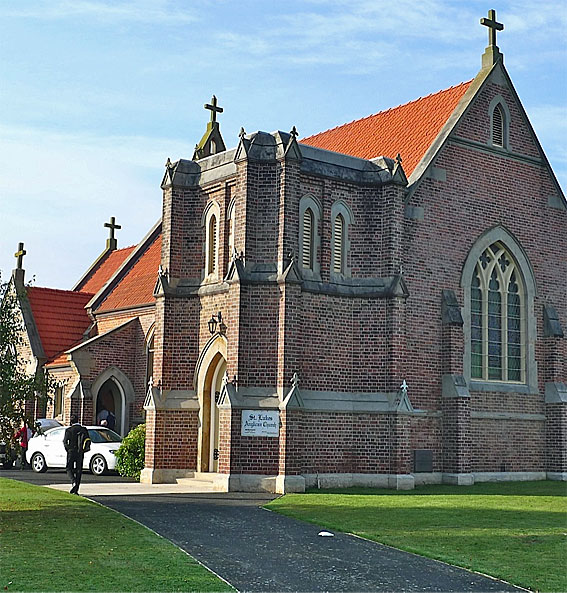
St Luke's Anglican Church, Latrobe : exterior
[photograph by Trevor Bunning 30 April 2011)]

St Luke's Anglican Church, Latrobe : exterior
[photograph by Trevor Bunning (30 April 2011)]
Historical and Technical Documentation by John Maidment
© OHTA (last updated May 2011)

St Luke's Anglican Church, Latrobe : exterior
[photograph by Trevor Bunning 30 April 2011)]

St Luke's Anglican Church, Latrobe : exterior
[photograph by Trevor Bunning (30 April 2011)]
The present St Luke's Anglican Church was dedicated in December 1909. The design was described as "modern decorated Gothic on concrete foundations" and the building was constructed in brick with Marseilles tiles employed for the roof.1 The construction was carried out by Mr H. Biggins, and the building cost £1500.
A Mason & Hamlin "Queens' Model" reed organ was installed in the previous building in 1901.2 It was reported in 1909 that the old organ from St John's Anglican Church, Devonport was being rehabilitated and presented to St Luke's Church.3 This was stated to have been given by Mr A. Munnew, together with an electric blower.4 Geo. Fincham & Son corresponded with Munnew in January 1909.5 Munnew also gave a Bevington & Sons organ to St John's Anglican Church, West Devonport in the same year.6
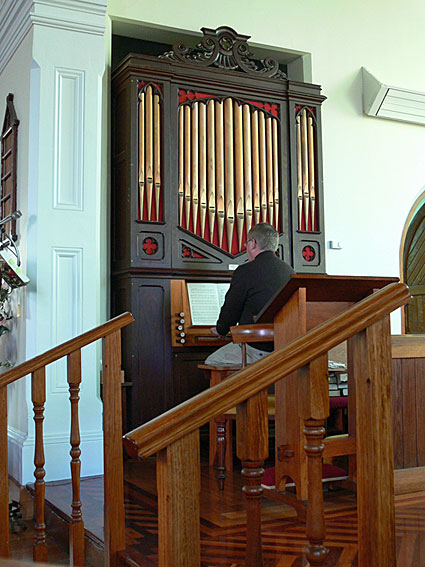
St Luke's Anglican Church, Latrobe : organ – Dr Kelvin Hastie demonstrating the instrument
[photograph by John Maidment (30 April 2011)]
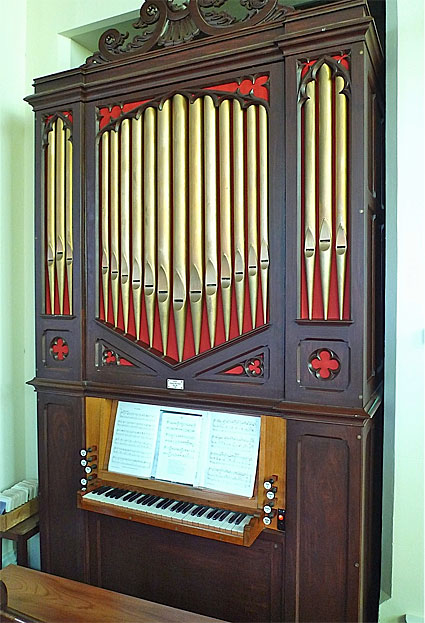
St Luke's Anglican Church, Latrobe : organ
[photograph by Trevor Bunning (30 April 2011)]
The present organ at St Luke's Church is believed to be the work of the Launceston-based organbuilder Jesse Biggs who also built the organ now at St Paul's Anglican Church, East Devonport, almost certainly in 1864.7 Jesse Biggs was born in London on 13 November 1819 and died on 23 August 1872 in Launceston, Tasmania of dropsy. After training with Gray & Davison in London, he is known to have built one organ in Britain before his emigration – at St Margaret's Church, Stanford Rivers, Essex, but this appears no longer to exist. Arriving in Melbourne in 1856, he built the first organ in Holy Trinity Church, Williamstown, Victoria, opened in July 1857 and in 1859 moved to Hobart, Tasmania where he erected major organs at St Andrew's Presbyterian Church, Hobart, the Mechanics' Institute, Launceston and Hobart Town Hall. He also 'perfected' the imported organ at St David's Cathedral, Hobart. He is likely to have provided assistance to the Launceston organbuilder Samuel Joscelyne. He was also said to be the most competent exponent of the bassoon in Tasmania. In 1871 he returned to Geelong to carry out work at Christ Church and All Saints' Church.8 According to contemporary newspapers now available online, Biggs appears now to have built a number of organs in Victoria and Tasmania, of which only a handful survive intact.
This instrument would almost certainly date from the 1860s. It is very unlikely that the organ was built by Joscelyne as his two surviving organs both have cedar casework, brass nameplates and the drawstops in a single line above the keys; the Latrobe organ also has chamfered case panels (also employed on the c.1858 organ attributed to Biggs now at St Luke's Lutheran Church, Cavendish, Victoria). The casework at St Luke's is of interest for its blending of Classical and Gothic motifs, a mixture of styles which might have been entirely appropriate for a Georgian "Gothicke' house such as can be found in Tasmania. The pipes in the central flat are placed on a v-shaped toeboard, while the elaborate cresting placed above the cornice recalls that used on the Joscelyne organ at St James-the-Great Anglican Church, East St Kilda. It is interesting, though, that it is constructed of stained deal or pine, rather than cedar.
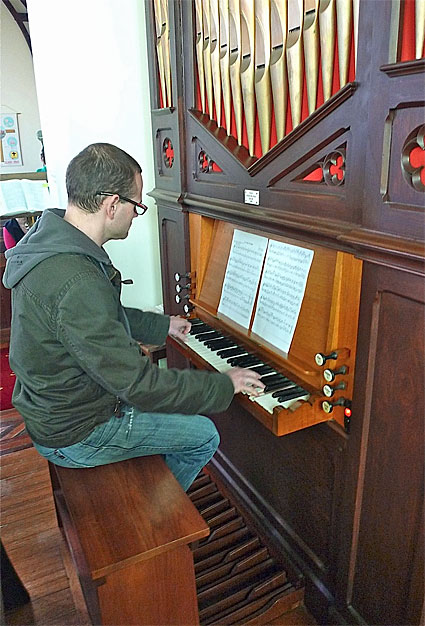
St Luke's Anglican Church, Latrobe : organ console – Dr Andrew Mariotti performing
[photograph by Trevor Bunning (30 April 2011)]
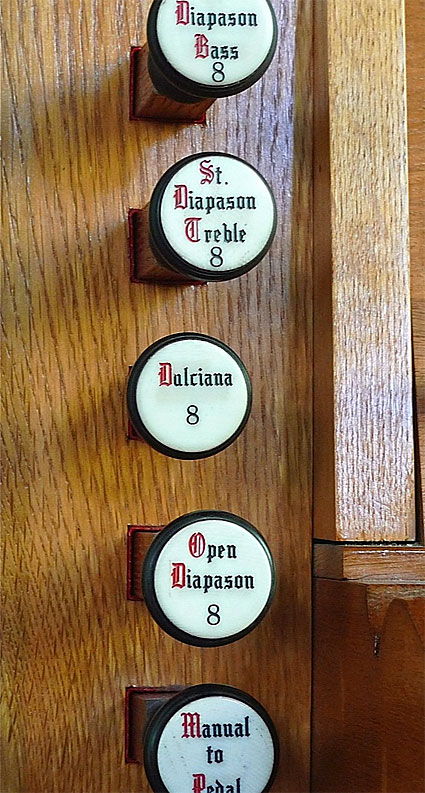
St Luke's Anglican Church, Latrobe : organ console – left jamb showing drawstops
[photograph by Trevor Bunning (30 April 2011)]
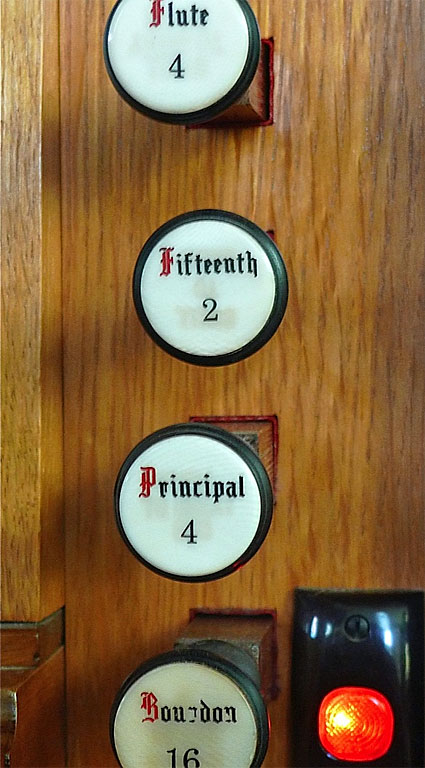
St Luke's Anglican Church, Latrobe : organ console – right jamb showing drawstops
[photograph by Trevor Bunning (30 April 2011)]
The organ was extensively restored by Australian Pipe Organs Pty Ltd, of Melbourne, in 1986. The casework and dummy wooden facade pipes were refinished, the action and wind system restored, and the pipework regulated. A new Fifteenth 2ft was installed in place of a former Gamba and new drawstops, music desk and oak stop jambs replaced the damaged originals.
| MANUAL Open Diapason St Diapason Bass St Diapason Treble Dulciana Principal Flute Fifteenth Manual to Pedal coupler PEDAL Bourdon |
8 8 8 8 4 4 2 16 |
TC CC-BB TC TG, TC-TF# gvd 1986 later addition |
Compass: 54/20
Mechanical key and stop action9
There are also references to an organ by J.W. Walker being placed in the church before 1922. This was a two-manual instrument of 14 speaking stops commissioned by Dr William Valentine, of 'The Grange', Campbell Town in 1867 and which is now at St Andrew's Presbyterian Church, Launceston, greatly altered. This instrument could not have been accommodated in the present organ recess, which is barely adequate for the instrument described above.
1 Launceston Examiner, 13 December 1909, p.7
2 Launceston Examiner, 8 June 1901, p.9
3 The Mercury, 13 January 1909, p.2
4 Launceston Examiner, 13 December 1909, p.7
5 Letter from Arthur Munnew, "Meercroft", Devonport W. to Geo. Fincham & Son 22 January 1909 (George Fincham & Sons letters, State Library of Victoria)
6 The Mercury, 13 January 1909, p.2
7 Launceston Examiner, 7 May 1864, p.5
8 National Trust of Australia (Victoria) classification report for the organ now in St Luke's Lutheran Church, Cavendish, Vic (November 2010). This organ is very likely the work of Jesse Biggs c.1858 before moving to Tasmania.
9 Specification noted 1970 John Maidment and later amended